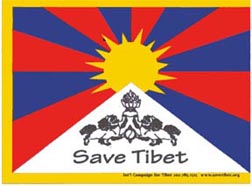(Part of the "Sacred Circles" Art Unit)
Students were introduced to Tibetan mandalas and the people who make them through lectures, photographs, and reading assignments. In addition to being exposed to the artwork of Tibet, we discussed Buddhism and the political changes in the country since the 1959 invasion by Communist China. Many of Tibet's temples and monasteries were destroyed during the Cultural Revolution, and Tibetan monks and nuns have since been persecuted and forced to live as refugees.
They also learned about H.H. the Dalai Lama, the spiritual and former political ruler of Tibet, who now lives in exile. The Dalai Lama is believed to be the 14th reincarnation of Buddha, and he won the 1989 Nobel Peace Prize for his non-violent opposition to continued Chinese rule in Tibet.
Students have a deeper appreciation of the efforts that Tibetan refugees have made to try to preserve their culture through sharing their art, music, dance, and traditions with the world.
 Students also watched the movie "Little Buddha". While it is not a particulary well-crafted film (with a couple of confusing story lines), the costumes and scenery are beautiful, and it tells the story of "Siddhartha" (the man who became the Buddha), thus giving an introduction to Buddhism. It also includes brief sections which show a prayer wheel in Kathmandu, and monks creating a sand mandala. They enjoyed watching it, and were well-prepared for our trip to the museum for the special Tibetan art exhibit.
Students also watched the movie "Little Buddha". While it is not a particulary well-crafted film (with a couple of confusing story lines), the costumes and scenery are beautiful, and it tells the story of "Siddhartha" (the man who became the Buddha), thus giving an introduction to Buddhism. It also includes brief sections which show a prayer wheel in Kathmandu, and monks creating a sand mandala. They enjoyed watching it, and were well-prepared for our trip to the museum for the special Tibetan art exhibit.

1. The white snow mountain in the center depicts the land of the nation of Tibet.
2. The six red rays emanating from the sun symbolize the six original peoples of Tibet: the Se, Mu, Dong, Tong, Dru, and Ra.
3. The blue rays symbolize the commitment to spiritual and secular rule.
4. The pair of snow-lions symbolize the complete victory of the spiritual and secular ruling government.
5. The three-sided yellow border represents the flourishing of the Buddha's teachings. The side without a border represents Tibet's openness to non-Buddhist thought.
6. The raised jewel symbolizes Tibet's reverence for the three Precious Gems: the Buddha, the Dharma, and the Sangha.
BACK